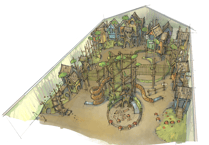BIG changes to the landscape are becoming more evident because of ash dieback.
Cowdray Estate has already swung into action with a comprehensive roadside tree safety management project, with a further programme to remove trees suffering from the disease due to take place from mid-April along the A286 between Midhurst to Singleton.
These essential works are part of the estate’s ongoing commitment to public safety and will remove diseased trees from areas where they potentially pose the highest risk to highways and public areas.
Cowdray are working alongside multiple neighbouring landowners, including the Forestry Commission, to minimise disruption and to carry out the work as efficiently as possible.
Cowdray Foresters have already carried out comprehensive work on main roads that run through the estate including the A286 north of Easebourne and on minor roads around Bepton and Elstead. These areas contained high concentrations of infected ash trees.
First confirmed in Britain in 2012, ash dieback is a disease caused by a fungus which causes leaf loss, crown dieback and bark lesions in affected trees.
Once a tree is infected, the disease is usually fatal, either directly or indirectly as the disease weakens the trees making them vulnerable to other infections.
The disease is spread by released spores and has swept across Europe over the past 20 years.
There is no cure for the disease, although it is thought a very small percentage of trees will have an in-built resistance. In the future, these trees may hold the key to regenerating ash trees.
Richard Everett, forest manager at Cowdray, said: “We apologise in advance for any inconvenience. This vital work reflects our commitment to public safety and forest management.”




Comments
This article has no comments yet. Be the first to leave a comment.